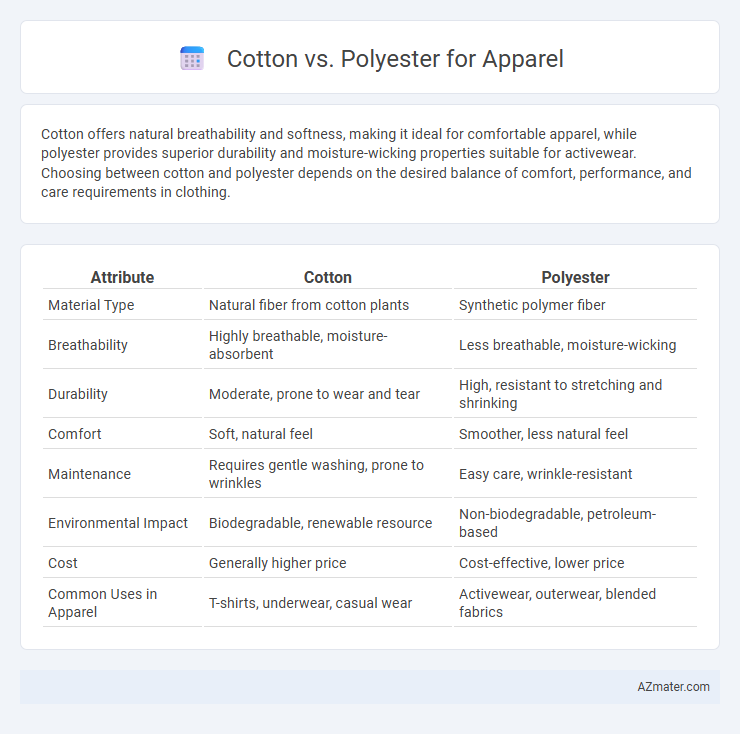Cotton offers natural breathability and softness, making it ideal for comfortable apparel, while polyester provides superior durability and moisture-wicking properties suitable for activewear. Choosing between cotton and polyester depends on the desired balance of comfort, performance, and care requirements in clothing.
Table of Comparison
| Attribute | Cotton | Polyester |
|---|---|---|
| Material Type | Natural fiber from cotton plants | Synthetic polymer fiber |
| Breathability | Highly breathable, moisture-absorbent | Less breathable, moisture-wicking |
| Durability | Moderate, prone to wear and tear | High, resistant to stretching and shrinking |
| Comfort | Soft, natural feel | Smoother, less natural feel |
| Maintenance | Requires gentle washing, prone to wrinkles | Easy care, wrinkle-resistant |
| Environmental Impact | Biodegradable, renewable resource | Non-biodegradable, petroleum-based |
| Cost | Generally higher price | Cost-effective, lower price |
| Common Uses in Apparel | T-shirts, underwear, casual wear | Activewear, outerwear, blended fabrics |
Introduction to Cotton and Polyester Fabrics
Cotton fabric, derived from natural cotton fibers, is renowned for its breathability, softness, and hypoallergenic properties, making it a popular choice for comfortable apparel. Polyester, a synthetic fiber produced through petrochemical processes, offers high durability, wrinkle resistance, and moisture-wicking capabilities, which enhance performance in activewear and outerwear. Understanding the fundamental differences in origin, texture, and functionality between cotton and polyester is essential for selecting the appropriate fabric for specific clothing needs.
Fiber Origin: Natural vs Synthetic
Cotton, derived from the natural fibers of the cotton plant, offers breathability, softness, and biodegradability, making it a popular choice for comfortable and eco-friendly apparel. Polyester, a synthetic fiber produced from petroleum-based chemicals, provides enhanced durability, moisture-wicking properties, and resistance to shrinking and wrinkles, ideal for activewear and long-lasting garments. The fiber origin significantly influences apparel performance, environmental impact, and consumer preferences in textile applications.
Comfort and Breathability
Cotton apparel offers superior comfort and breathability due to its natural fibers that allow air circulation and moisture absorption, keeping the skin dry and cool. Polyester fabrics, made from synthetic fibers, tend to trap heat and moisture, which can cause discomfort during extended wear or in hot conditions. Choosing cotton is ideal for those prioritizing softness and ventilation, while polyester suits activities requiring durability and moisture-wicking properties.
Durability and Longevity
Polyester outperforms cotton in durability and longevity due to its synthetic fibers, which resist stretching, shrinking, and abrasion more effectively. Cotton, while breathable and soft, tends to wear out faster with frequent washing and exposure to sunlight, leading to fiber breakdown. Choosing polyester ensures longer-lasting apparel suitable for active wear and high-use garments.
Moisture Management and Quick Drying
Cotton fibers absorb moisture efficiently but retain it, resulting in slower drying times and reduced comfort during intense physical activity. Polyester fabrics offer superior moisture-wicking properties, pulling sweat away from the skin to the fabric surface where it evaporates quickly. This moisture management and rapid drying ability make polyester the preferred choice for performance apparel and activewear.
Environmental Impact
Cotton cultivation requires significant water usage and pesticides, leading to soil degradation and habitat loss, while polyester production involves petroleum-based processes contributing to carbon emissions and microplastic pollution. Biodegradability of cotton reduces long-term waste compared to polyester, which persists in landfills for hundreds of years. Sustainable alternatives include organic cotton and recycled polyester, both minimizing environmental impact in apparel manufacturing.
Maintenance and Care Requirements
Cotton apparel requires gentle washing with mild detergents and benefits from air drying to prevent shrinking and maintain softness. Polyester fabrics are more durable, resistant to wrinkles and shrinking, and can be machine washed and dried with less risk of damage. Proper care extends the lifespan of both materials by preventing color fading and preserving fabric integrity.
Cost Comparison
Cotton apparel generally costs more upfront due to higher raw material and processing expenses compared to polyester, which is less expensive to produce from synthetic fibers. Polyester garments offer better durability and lower maintenance costs, often making them more cost-effective over time despite initial price differences. Wholesale prices for cotton fabrics typically range from $1.50 to $4.00 per yard, while polyester fabrics are usually priced between $0.50 and $2.00 per yard, highlighting significant cost savings for manufacturers using polyester.
Common Uses in Apparel
Cotton is widely used in casual wear, t-shirts, and underwear due to its natural breathability, softness, and moisture absorption properties, making it ideal for comfort. Polyester is favored in activewear, outerwear, and sports uniforms because of its durability, wrinkle resistance, and quick-drying capabilities. Blended fabrics combining cotton and polyester offer versatility, balancing comfort and performance for everyday apparel.
Choosing the Right Fabric for Your Needs
Cotton offers superior breathability and natural moisture absorption, making it ideal for comfort in warm weather and sensitive skin. Polyester provides enhanced durability, wrinkle resistance, and quicker drying times, suited for activewear and outdoor garments. Selecting the right fabric depends on balancing comfort, maintenance, and performance based on your specific apparel requirements.

Infographic: Cotton vs Polyester for Apparel
 azmater.com
azmater.com